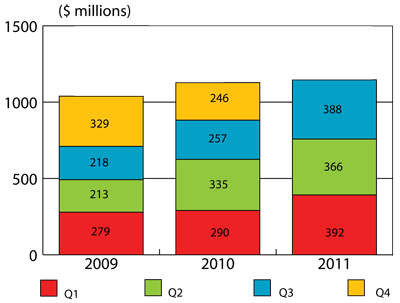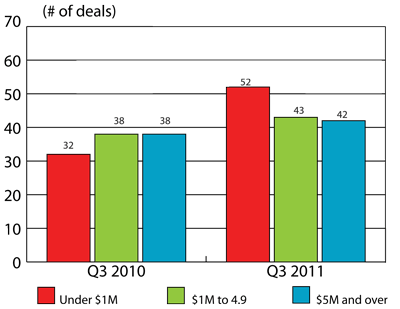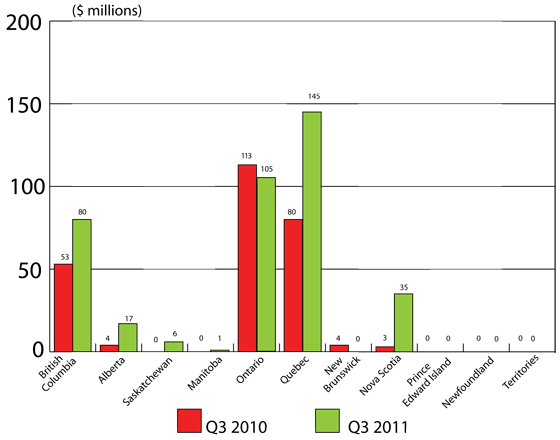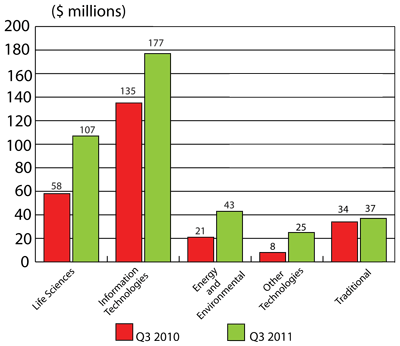PDF Version
Venture Capital Monitor - Q3 2011
150 KB, 6 pages
Canadian high growth innovative small and medium-sized enterprises (SMEs) that commercialize research depend to a large extent on the venture capital (VC) industry for funding. Therefore, a strong VC industry is important for the growth of this segment of SMEs. The goal of this series is to provide current information about the VC industry in Canada. To this end, the series will track trends in investment activity, report on topical VC-related research and look at key technology clusters where VC investment is taking place.
Introduction
The issue discusses venture capital (VC) in Canada during the third quarter of 2011. It also describes recent government activity by the Business Development Bank of Canada (BDC) and provincial governments in support of VC.
VC activity overview
Investment and fundraising
Significant investment growth in Q3 2011
In terms of total VC investment, Q3 2011 was the most active quarter in almost four years as $388 million was invested in 137 firms across Canada. This represents a 51 percent increase from the $257 million invested in 108 companies over the same period the year before (Table 1). This growth is largely attributable to several high dollar-intensive late-stage financing rounds and overall growth of deal sizes during the quarter, with a greater proportion of financing originating from domestic sources than traditionally. As a result of Q3 2011 activity, year-to-date VC investment in 2011 ($1.15 million) has already surpassed the 2010 annual total ($1.13 million) with one quarter still remaining (Figure 1).
| Q3 2010 | Q3 2011 | % Change | |
|---|---|---|---|
| ($ millions) | |||
| Source: Thomson Reuters Canada 2011. | |||
| Investment | 257 | 388 | 51 |
| Fundraising | 47 | 365 | 677 |
Figure 1: VC Investment by quarter, 2009 to 2011

Source: Thomson Reuters Canada 2011.
Fundraising by Canadian VC funds also grew during the third quarter. These funds raised $365 million over Q3 2011, substantially outpacing the $47 million raised over the same period in 2010. Over three quarters of 2011, new commitments totalled $739 million, just short of the $741 million committed the year before over the same period. Approximately half of the new supply brought into the market during the quarter was accounted for by the launch of the $180 million OMERS Ventures institutional fund. The remaining balance was split between private independent partnerships and retail funds.
Deal Size
Q3 2011 average deal sizes 19 percent larger than Q3 2010 deal sizes
During Q3 2011, 137 firms received VC financing, which is a 29 percent increase from the 108 deals completed in Q3 2010. In particular, there was substantial growth in the number of deals worth less than $1 million dollars (Figure 2). Despite this, average deal size actually increased about 19 percent as a result of an increase in large deals worth more than $5 million. These larger VC financing deals in the third quarter led to an increase in VC deal sizes in Canada relative to those in the United States.
Figure 2: Distribution of VC investment by deal size, Q3 2010 and Q3 2011

Source: Thomson Reuters Canada 2011.
Stage of development
Majority of new investment dollars concentrated in later stage investments
Approximately 71 percent of VC invested into Canadian companies in Q3 2011 was in the form of later-stage financing. There was $276 million invested into 87 later-stage companies during Q3 2011, nearly 80 percent higher than the $154 million invested into 62 companies during Q3 2010. Average deal sizes for later-stage deals grew from $2.4 million in Q3 2010 to over $3 million per deal during Q3 2011 while total seed and start-up investments also grew slightly over the quarter.
Figure 3: VC investment value by stage of development, Q3 2010 and Q3 2011

Source: Thomson Reuters Canada 2011.
New versus follow-on investments
High level of follow-on investments observed during the quarter
First-time VC deals reached a six year single quarter high as 63 companies received first round financing during Q3 2011, a 54 percent increase compared to the same period the previous year. During the quarter $95 million went into these new deals, a 37 percent increase from Q3 2010. The majority of new financings during the quarter occurred as later-stage investments, with seed and start-up deals also experiencing notable growth for the same year-over-year period.
There were 74 total follow-on deals during Q3 2011, a moderate increase on the 67 deals completed over the same period in 2010. Total deal value of follow-on deals during the quarter demonstrated 57 percent growth relative to Q3 2010, measuring just over $293 million in deal value (Table 2).
| Investments | Q3 2010 | Q4 2010 | Q1 2011 | Q2 2011 | Q3 2011 | |
|---|---|---|---|---|---|---|
| Source: Thomson Reuters Canada 2011. | ||||||
| New | Seed/ start-up | 5 | 5 | 20 | 12 | 24 |
| Other early stages | 4 | 9 | 3 | 3 | 2 | |
| Later stage | 32 | 34 | 35 | 39 | 37 | |
| All | 41 | 48 | 58 | 54 | 63 | |
| Follow-on | Seed/ start-up | 9 | 14 | 9 | 15 | 11 |
| Other early stages | 28 | 12 | 22 | 19 | 13 | |
| Later stage | 30 | 41 | 37 | 47 | 50 | |
| All | 67 | 67 | 68 | 81 | 74 | |
Type of investor
Increase among private independent fund investors
Private independent funds were the most active investors during the quarter while foreign funds, retail funds and government all invested less than during Q3 2010. Private independent funds invested approximately $146 million during the quarter, a 109 percent increase on the 70 percent invested during Q3 2010 and the highest single quarter level posted by private independent funds in over a decade. Other investors, such as banks and corporate funds, were highly active during the quarter having invested about $78 million.
Foreign funds, retail funds/Labour Sponsored Venture Capital Corporations (LSVCCs) and government funds each experienced decreased investment levels during this most recent quarter. LSVCC's invested almost 44 million during the quarter, almost 24 percent less than over the same period in 2010. As expected the majority of LSVCC investments were made in Quebec ($23 million). However, LSVCCs were highly active in British Columbia ($10 million) and Saskatchewan ($6 million) doubling Q3 2010 investments in each province respectively.
Direct government VC investments declined for the third consecutive quarter falling from $30 million in Q3 2010 to $26 million in Q3 2011 as private independent investors appear to be returning to pre-recession investment levels. The amount invested by foreign funds also declined during Q3 2011 over the same period last year as Canadian firms attracted approximately $79 million from foreign investors (Figure 4). This represented a fifth of total VC dollars invested into Canadian companies during Q2 2011, which is substantially less than the traditional market share of foreign funds in Canada.
Figure 4: Distribution of VC investment by type of investor, Q3 2010 and Q3 2011

Source: Thomson Reuters Canada 2011.
Fundraising
OMERS Ventures highlights strong fundraising quarter
Fundraising by Canadian VC funds also improved over the third quarter as $365 million in new capital was brought into the market over Q3 2011 a substantial increase over Q3 2010 when only $47 million was raised. The main source for new capital over the period was the October launch of a new $180 million institutional fund by OMERS Ventures. The fund will be internally managed by the pension fund and will have a unique role in its industry, as both an institutional angel investor and a later-stage investor. As a lifecycle investor, OMERS Ventures investments could range anywhere from an initial seed round investment ($500 000 to $2 million), to a larger growth capital round (up to $30 million).
Remaining fundraising during the quarter was predominately split between private independent partnerships and retail funds. VC partnership closings contributed a total of $83 million to activity in Q3 2011 and retail funds brought an additional $89 million into the market. Over the first three quarters of 2011, new commitments total $739 million just short of the $741 million committed the year before over the same period.
Regional distribution
Increase in VC investment value in Ontario and Quebec
Total financings of Quebec-based businesses increased by 52 percent compared to the same period last year. On average deal sizes in the province averaged slightly higher than $1.8 million, 20 percent higher than average deals sizes during Q3 2010. Despite smaller average deal sizes than in the rest of Canada, the volume of completed deals in the province helped Quebec attract 37 percent of total investment dollars placed in Canada and to lead Canadian VC financing during the quarter. Notably, the majority of investments placed in Quebec were made by private investors who outpaced retail investors in the province for only the second time in a decade.
Completed deal financings in Ontario remained consistent as 34 deals were completed during each of Q3 2010 and Q3 2011. Despite this, deal sizes were slightly smaller causing the total investment value to drop from $113 million in Q3 2010 to $105 million during Q3 2011. VC investment grew in Western Canada as firms in British Columbia and Alberta attracted $80 million and $17 million respectively during Q3 2011 compared to $53 million and $4 million over the same period in 2010. Very little deal activity was completed in the East Coast with the exception of Nova Scotia, which experienced its most active quarter ever with $35 million invested in four deals, compared to $3 million in 2 deals in Q3 2010 (Table 3 and Figure 5).
| Province | Q3 2010 | Q3 2011 | % Change |
|---|---|---|---|
| Source: Thomson Reuters Canada 2011. | |||
| British Columbia | 8 | 12 | 50 |
| Alberta | 7 | 4 | −43 |
| Saskatchewan | 1 | 3 | 200 |
| Manitoba | 2 | 1 | −50 |
| Ontario | 34 | 34 | 0 |
| Quebec | 52 | 79 | 52 |
| New Brunswick | 2 | 0 | −100 |
| Nova Scotia | 2 | 4 | 100 |
| Prince Edward Island | 0 | 0 | n/a |
| Newfoundland & Labrador | 0 | 1 | n/a |
| Territories | 0 | 0 | n/a |
Figure 5: Regional distribution of VC investment in Canada, Q3 2010 and Q3 2011

Source: Thomson Reuters Canada 2011.
Sector distribution
Increase in capital attracted by energy and environmental firms
All sectors experienced increased investment activity during Q3 2011 versus Q3 2010. Information and communication technology (ICT) firms attracted the most VC financing, having attracted $177 million (46 percent of all financing). While down from the first two quarters of 2011, VC investments into energy and environmental firms during the quarter were higher than Q3 2010. Life sciences also experienced a very strong quarter buoyed by several large later stage deals (Figure 6).
Figure 6: VC investment by industry sector, Q3 2010 and Q3 2011

Source: Thomson Reuters Canada 2011.
Government activities
Business Development Bank of Canada activities
The Business Development Bank of Canada (BDC) was relatively inactive in direct investment over the quarter, making only four VC commitments totalling $2.4 million. These financings were worth a total of $13.8 million including contributions by co-investors. On top of direct financings, the BDC contributed nearly $35 million to two private independent funds in Toronto and Montréal, which had cumulative closings of approximately $367 million (Table 4).
| BDC | Co-investors | Total | Number of deals | |
|---|---|---|---|---|
| ($ million) | ||||
| Note: Numbers may not add up due to rounding. Source: Business Development Bank of Canada. | ||||
| Seed and start-up | 0.0 | 0.0 | 0.0 | 0 |
| Development | 2.1 | 11.2 | 13.3 | 3 |
| Later stage | 0.3 | 0.3 | 0.5 | 1 |
| Total | 2.4 | 11.5 | 13.8 | 4 |
Notes
This publication is part of a series prepared by the Small Business Branch. The branch analyses the financial marketplace and how trends in this market impact small businesses' access to financing. Current research is focused on high-growth firms, the aspects of both Canada's VC and general business environment that affect the success of these firms, and the key players in the risk-capital market (for example, VC firms and angels).
To be added to the distribution list for this quarterly publication, please make your request at the Subscribe to Publications page.
For questions related to its content, please email SBB-DGPE.
